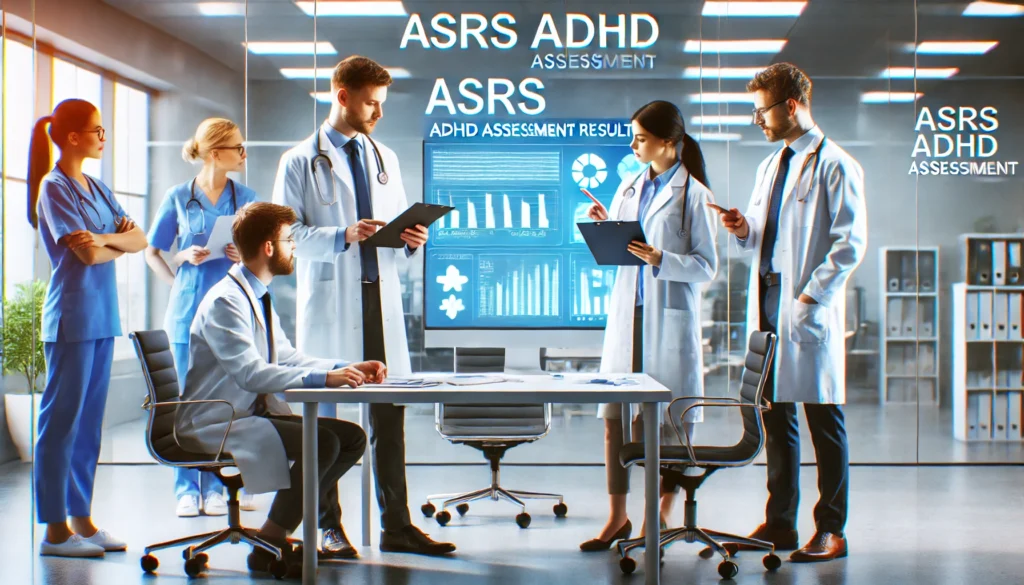Attention Deficit Hyperactivity Disorder (ADHD) is a prevalent neurodevelopmental disorder that affects both children and adults. While much attention has been given to diagnosing ADHD in children, adult diagnosis is equally crucial. One of the primary tools used in the assessment process is the Adult ADHD Self-Report Scale (ASRS). This article delves into the ASRS, exploring its role in ADHD diagnosis, its historical background, current applications, and its implications for the future.
You may also like: Enhancing Concentration: Strategies for ADHD
Understanding the ASRS
The Adult ADHD Self-Report Scale (ASRS) is a self-administered questionnaire designed to identify symptoms consistent with ADHD in adults. Developed in conjunction with the World Health Organization (WHO) and the Workgroup on Adult ADHD, the ASRS provides a structured method for evaluating the presence and severity of ADHD symptoms.
Historical Context
ADHD was first recognized as a clinical diagnosis in children during the early 20th century. The initial focus was on hyperactivity and impulsivity, often observed in school settings. However, as research progressed, experts began to see patterns indicating that ADHD could persist into adulthood. It wasn’t until the late 20th and early 21st centuries that the medical community formally acknowledged this persistence. This recognition highlighted the need for diagnostic tools tailored for adults, leading to the development of the ASRS. The shift in understanding also prompted a reevaluation of symptoms, considering how they manifest differently in adults compared to children.
Development and Collaboration
The creation of the ASRS was the result of a collaborative effort among international experts. The World Health Organization (WHO) played a pivotal role in its development, ensuring that it met global standards for psychological assessment tools. The Workgroup on Adult ADHD, comprising leading psychiatrists and psychologists, provided critical insights into adult-specific symptoms. Their collaboration aimed to create a tool that was both scientifically robust and easy to administer. The involvement of these organizations ensured that the ASRS was backed by rigorous research and could be widely adopted across different healthcare settings.
Structure of the ASRS
The ASRS consists of 18 questions that align with the diagnostic criteria for ADHD outlined in the Diagnostic and Statistical Manual of Mental Disorders (DSM-5). Each question is carefully crafted to reflect the core symptoms of ADHD, such as inattention, hyperactivity, and impulsivity. The questions are designed to assess the frequency of symptoms, ranging from “never” to “very often,” capturing the nuances of symptom expression. The first six questions, known as the ASRS Screener, are particularly indicative of ADHD and are used for initial screening. These questions focus on the most prevalent symptoms that can disrupt daily functioning, offering a quick way to identify individuals who may need further evaluation.
Cultural and Global Adaptability
One of the strengths of the ASRS is its adaptability across different cultures and languages. Recognizing ADHD symptoms can vary due to cultural influences, the ASRS has been translated and validated in multiple languages. This adaptability ensures that healthcare providers worldwide can use the tool effectively, maintaining its reliability and validity. Global studies have helped refine the tool, addressing cultural nuances in symptom expression and interpretation. This ongoing adaptation process underscores the ASRS’s commitment to being an inclusive and universally applicable diagnostic tool.

Scoring and Interpretation
The scoring of the ASRS is straightforward yet nuanced. Each response is assigned a value, and the cumulative score helps determine the likelihood of ADHD. The ASRS is divided into two parts: Part A (the Screener) and Part B. A high score in Part A suggests the need for a comprehensive evaluation by a healthcare professional.
ASRS v1.1 Score Interpretation
The ASRS v1.1 is the most current version, offering a refined approach to scoring. It uses a threshold score to suggest the presence of ADHD symptoms. The scoring system is designed to be sensitive enough to detect subtle symptoms that may be overlooked in a clinical setting. However, it is essential to note that the ASRS is not a diagnostic tool but rather a screening instrument. A thorough clinical assessment is necessary to confirm a diagnosis, taking into account the individual’s history and other potential conditions.
Importance of Professional Interpretation
While the ASRS provides a preliminary indication of ADHD, professional interpretation is crucial for accurate diagnosis. Mental health professionals consider the ASRS scores alongside clinical interviews and other diagnostic tests to form a comprehensive view of the individual’s condition. This process helps differentiate ADHD from other disorders with overlapping symptoms. Professionals also assess the impact of symptoms on daily life, which is a key factor in determining the need for treatment. The ASRS serves as a starting point, guiding professionals in their diagnostic journey.
Limitations and Considerations
While the ASRS is a valuable tool, it is not without limitations. The self-report nature of the questionnaire can introduce bias, as individuals may underreport or overreport symptoms based on their perceptions. Cultural differences can also affect responses, as societal norms influence how symptoms are expressed and perceived. Additionally, comorbid conditions such as anxiety or depression can influence the accuracy of the results, complicating the interpretation. Therefore, the ASRS should be used as part of a comprehensive assessment strategy, incorporating multiple sources of information for a well-rounded diagnosis.

The ASRS in Clinical Practice
The ASRS is widely used in clinical settings, providing a quick and efficient method for identifying potential ADHD symptoms in adults. Healthcare professionals often use the ASRS alongside other diagnostic tools, such as clinical interviews and observational assessments, to make a well-rounded diagnosis.
Integrating ASRS with Other Tools
In practice, the ASRS is often used in conjunction with other assessment tools, such as the Vanderbilt ADHD Test for Adults and the ADHD Rating Scale (ADHD-RS). This multi-method approach ensures a comprehensive evaluation of the individual’s symptoms and functioning. By combining different tools, clinicians can cross-validate findings, enhancing the accuracy of the diagnosis. This integration helps capture a complete picture of the individual’s cognitive and behavioral patterns, leading to more personalized treatment plans.
Practical Applications in Healthcare
For healthcare providers, the ASRS serves as a valuable asset in routine assessments. Its ease of administration allows for quick screening in busy clinical settings, enabling early identification of potential ADHD cases. The ASRS can be used as part of annual health check-ups, ensuring that adults who may have undiagnosed ADHD receive timely evaluation and intervention. By incorporating the ASRS into standard practice, healthcare professionals can improve patient outcomes through early detection and management.
Role in Coaching and Counseling
For health and wellness coaches, the ASRS can serve as a preliminary tool to identify clients who may benefit from further evaluation. Coaches can use the ASRS to recognize patterns of behavior that align with ADHD symptoms, providing a basis for referral to mental health professionals. By understanding the role of the ASRS, coaches can provide informed guidance and support to their clients, enhancing their overall well-being. This proactive approach can empower individuals to seek help, improving their quality of life and personal growth.

Future Implications
The ASRS continues to play a significant role in ADHD diagnosis, with ongoing research focused on improving its accuracy and applicability. As our understanding of ADHD evolves, so too will the tools we use to assess and diagnose it.
Advancements in ADHD Research
Recent advancements in ADHD research have highlighted the importance of personalized approaches to diagnosis and treatment. Researchers are exploring the integration of genetic, neuroimaging, and cognitive data to enhance the precision of ADHD assessments. This multidisciplinary approach could lead to the development of more sophisticated versions of the ASRS, capable of capturing complex symptom profiles. By aligning diagnostic tools with cutting-edge research, the field of ADHD assessment is poised for significant advancements.
The Role of Technology
Technology is poised to revolutionize ADHD diagnostics. Digital platforms and mobile applications may offer new ways to administer the ASRS and other assessment tools, making the evaluation process more accessible and efficient. These innovations could also facilitate real-time data collection and analysis, providing valuable insights into symptom patterns and treatment responses. By leveraging technology, healthcare providers can offer more dynamic and interactive assessment experiences, engaging individuals in their diagnostic journey.
Ethical and Privacy Considerations
As technology becomes more integrated into ADHD diagnostics, ethical and privacy considerations must be addressed. Ensuring the confidentiality of personal health information is paramount, particularly when using digital platforms for assessment. Researchers and clinicians must adhere to strict data protection protocols, safeguarding sensitive information. Additionally, the ethical implications of using advanced diagnostic tools must be considered, ensuring that they are used responsibly and equitably. By prioritizing ethical practices, the field can advance in a manner that respects individual rights and promotes trust.
Conclusion
The Adult ADHD Self-Report Scale (ASRS) is a pivotal tool in the assessment of ADHD in adults. Its structured approach provides a reliable method for screening symptoms, guiding individuals towards further evaluation and potential diagnosis. By understanding the role of the ASRS, health professionals, coaches, and individuals alike can better navigate the complexities of ADHD, paving the way for improved outcomes and enhanced quality of life.
As we move forward, continued research and technological advancements will undoubtedly shape the future of ADHD diagnostics, offering new possibilities for those affected by this condition. The ASRS, with its blend of historical significance and modern relevance, remains at the forefront of this evolving landscape, serving as a beacon of hope and understanding in the realm of adult ADHD assessment. The ongoing evolution of diagnostic tools promises a future where ADHD is more accurately identified and managed, enhancing the well-being of individuals worldwide.
Further Reading:
Adult ADHD Self-Report Scale (ASRS)
A Guide to ASRS v1.1 Adult ADHD Self-Assessment
Decoding ADHD: A Comprehensive Guide to the Adult ADHD Self-Report Scale
Important Note: The information contained in this article is for general informational purposes only, and should not be construed as health or medical advice, nor is it intended to diagnose, prevent, treat, or cure any disease or health condition. Before embarking on any diet, fitness regimen, or program of nutritional supplementation, it is advisable to consult your healthcare professional in order to determine its safety and probable efficacy in terms of your individual state of health.
Regarding Nutritional Supplements Or Other Non-Prescription Health Products: If any nutritional supplements or other non-prescription health products are mentioned in the foregoing article, any claims or statements made about them have not been evaluated by the U.S. Food and Drug Administration, and such nutritional supplements or other health products are not intended to diagnose, treat, cure, or prevent any disease.


